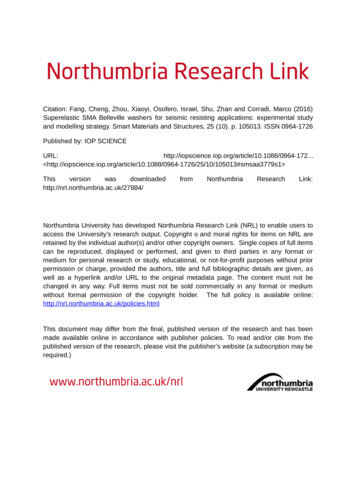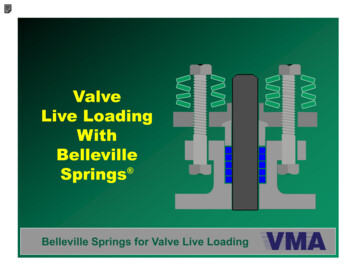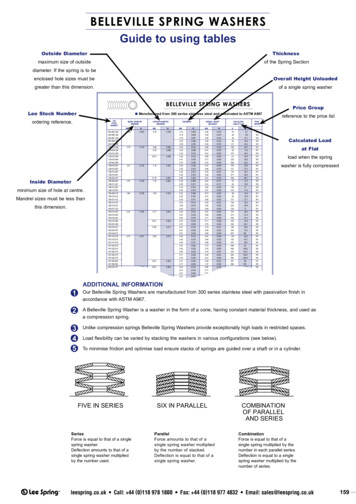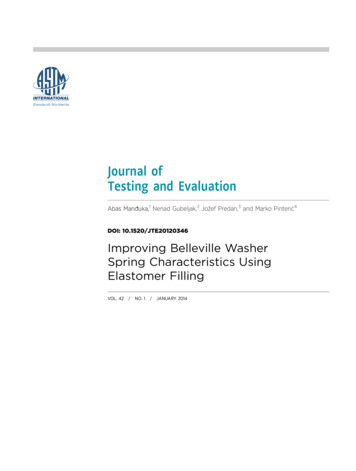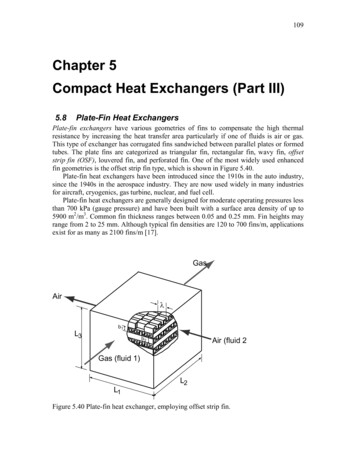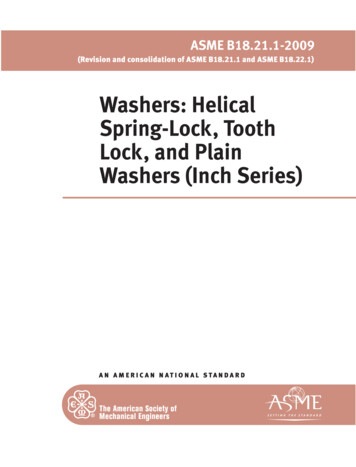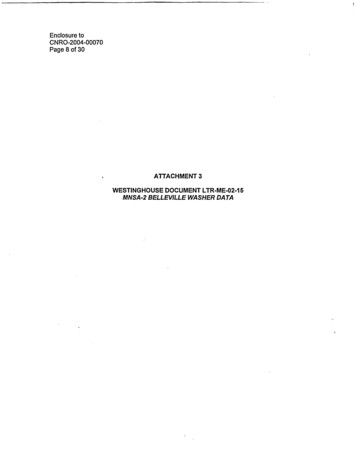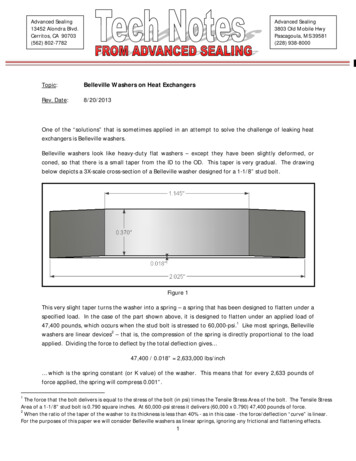
Transcription
Advanced Sealing13452 Alondra Blvd.Cerritos, CA 90703(562) 802-7782Advanced Sealing3803 Old Mobile HwyPascagoula, MS 39581(228) 938-8000Topic:Belleville Washers on Heat ExchangersRev. Date:8/20/2013One of the “solutions” that is sometimes applied in an attempt to solve the challenge of leaking heatexchangers is Belleville washers.Belleville washers look like heavy-duty flat washers – except they have been slightly deformed, orconed, so that there is a small taper from the ID to the OD. This taper is very gradual. The drawingbelow depicts a 3X-scale cross-section of a Belleville washer designed for a 1-1/8” stud bolt.Figure 1This very slight taper turns the washer into a spring – a spring that has been designed to flatten under aspecified load. In the case of the part shown above, it is designed to flatten under an applied load of47,400 pounds, which occurs when the stud bolt is stressed to 60,000-psi.1 Like most springs, Bellevillewashers are linear devices2 – that is, the compression of the spring is directly proportional to the loadapplied. Dividing the force to deflect by the total deflection gives 47,400 / 0.018” 2,633,000 lbs/inch which is the spring constant (or K value) of the washer. This means that for every 2,633 pounds offorce applied, the spring will compress 0.001”.1The force that the bolt delivers is equal to the stress of the bolt (in psi) times the Tensile Stress Area of the bolt. The Tensile StressArea of a 1-1/8” stud bolt is 0.790 square inches. At 60,000-psi stress it delivers (60,000 x 0.790) 47,400 pounds of force.2When the ratio of the taper of the washer to its thickness is less than 40% - as in this case - the force/deflection “curve” is linear.For the purposes of this paper we will consider Belleville washers as linear springs, ignoring any frictional and flattening effects.1
The use of Belleville washers on heat exchanger flanges is based on this spring deflection; as it isreasoned that the spring in the washer will keep the flanges tight if the gasket should relax or losethickness. 3So are Belleville washers the answer to offsetting the relaxation inherent in heat exchanger gaskets?Should they be routinely used to improve reliability and prevent leakage in heat exchanger joints? Theshort answer is “no”. The limited amount of good they do is more than offset by added cost, increasedcomplexity, and added failure modes. Here’s why.1. Mismatch of loads needed and deliveredThe real secret to sealing heat exchanger gaskets is GASKET STRESS. As of this writing, Chevron is themost successful operator of heat exchangers in North America – and arguably, the world. They havethousands of heat exchangers in operation; with zero reported leakage from turnaround to turnaround.Their experience teaches that exchanger gaskets must have a full-width seating stress between 12,000psi and 40,000-psi in order to run leak-free, with the exact amount dependent on the number and sizeof studs, the system pressure, the size, type and configuration of the gasket and other such factors.To attain these gasket stresses, Chevron often finds it necessary to take the stud stress well beyond60,000-psi – routinely going over 90,000-psi on studs under 1”. In many cases, studies show that studstresses lower than 50,000-psi under-loadthe gasket, and increase leakage risk.Here is the problem. If the dynamic rangeof the spring washer correlates to a studload of 0 – 60,000 psi, but the requiredgasket loads correlate to a stud load of50,000 – 90,000-psi, then much of thedynamic range of the washer will neverhelp seal the gasket. It is only the narrowoverlap between these ranges – the regionbetween 50,000-psi and 60,000-psi that thewasher can contribute to the sealing of thegasket. Because the washer is a linearspring, only 1/6th of the 0.018” cup in thewasher – or 0.003” – could effectivelycontribute to the sealing of the gasket. Therest of the relaxation in the washer occursat levels too low to prevent leakage.90,00080,000Sealingrange of thegasket70,00060,00050,000Dynamicrange oftheWasher40,00030,00020,00010,0000Figure 23“Relaxation” occurs due to a thinning of the gasket because of consolidation, deterioration, distortion,displacement, migration or compression of the gasket material. As the gasket thins, the elongation (or stretch) inthe studs is reduced, resulting in a drop of stud stress and gasket stress. Spring washers can reduce this stud loadloss by adding additional spring travel to the stud so it is less impacted by the amount of gasket relaxation.2
2. Increased ComplexityThe person well versed in Belleville washers will point out that the above explanation is far too simple,and that by combining a short stack of washers with either “up” or “down” orientation it is possible toachieve any spring rate (or K value) desired. This is true.Ignoring frictional effects, stacking two washers on top of each other facing inthe same direction (in parallel) doubles the force needed to deflect the samedistance, thereby doubling the K value; whereas stacking them in oppositedirections (in series) cuts the K value in half, creating a spring that movestwice the distance with the same force.Most often, Belleville washers are used in even stacks – that is, the same number of washers will befacing up or down in every part of the set; which results in a linear spring rate over the full range ofcompression. Even with that restriction, multiple set arrangements are possible – as can be seen inthese drawings showing a simple 4-washer set. In both cases, two of thewashers face up, and two face down. Both sets are also “even” sets, with thesame number of washers in each alternate-facingsegment. But the spring rate for the arrangementFigure 3shown in Figure 3 is only 25% of the spring rate forFigure 4that shown in Figure 4. The set in Figure 3 will compress 0.072” with just47,400 pounds of force, whereas the set in Figure 4 will compress just 0.036” with 94,800 pounds.No matter how many washers a set may have, or how they may be arranged, the resultant springconstant of a stack of washers (KT) can be determined by the following equation:KT K / ((1/N1) (1/N2) )Where:K the spring rate of one washer, andN the number of washers in each successive set in opposite orientation.So the stack of washers shown in Figure 5 wouldbe evaluated by the following equation:Figure 5KT K / ((1/1) (1/2) (1/3)) 0.546 KThis KT would prevail only until the single spring flattened out, essentially removing it from the stack.The remaining washers would then be evaluated as:KT K / ((1/2) (1/3)) 1.200 K until the two washers were compressed. At that point the remaining three washers would act as ifthey were alone, with a spring rate of :KT K / (1/3) 3.000 K3
As you can see, using different numbers of washers in alternating directions results in the setcompressing at different rates under different load ranges. It is this added level of complexity –resulting in a non-linearity in the spring response of the total set – that drives most users to design setswith the same number of washers in opposing directions.The ease with which these values can be computed means that custom Belleville washer sets can bedesigned to overlap gasket load requirements. For example, let’s take another look at the examplediscussed in Figure 2, this time using a 4-washer set as shown in Figure 4 instead of a single washer. Thespring rate of this set is given by:KT K / ((1/2) (1/2)) 1.00 K or exactly 2,630,000 lbs/inch, just as a single washer, but with twice the travel. As stated earlier, theset compresses evenly, and would compress 0.036” with 94,800 pounds of force – a load that would beequivalent to 120,000-psi stud stress4.Figure 5 shows the changes that would result.With this “optimized” set, just 33% of thecompression on the set of Belleville washers– or 0.012” – would be available to offsetrelaxation in the gasket before the load onthe gasket surface dipped to levels whichrisked leakage5.120,000110,000100,00090,000Dynamicrange oftheWasherSetWhile this exercise shows how Bellevillewasher sets can be used in a balancedapproach that takes into account the factorsthat control gasket seating stress, it alsodemonstrates the increased complexity thatargues against using them routinely.Sealingrange of thegasket80,00070,00060,00050,00040,000Routine use of Belleville washers as described30,000above would require that custom sets bedesigned for every flange connection on20,000every heat exchanger. In order to contribute10,000effectively to the seating load on the gasket,those sets would need to be designed with K0values that generate effective spring motionFigure 5in the range of stud stresses that would beapplied in a properly tensioned joint. The number of washers – and their exact orientation – wouldneed to be carefully communicated to the work crew; simply getting one washer upside down wouldmake the set far too soft (or hard) to contribute meaningful compression.4Since the yield on a B7 stud is 105,000-psi, this 120,000-psi value is merely a mathematical extrapolation, and isincluded here to discuss the spring characteristics of the washers.5For a more rigorous discussion of this example, see Appendix A4
What is the chance that an error can be made in installation? Significant. The number of unique waysthat a washer set can be configured (and the number of ways it can be done wrong) increases with thenumber of washers. A 4-washer set can be configured 5 different ways. An 8-washer set has 22 possiblecombinations.The ease with which the sets can be installed incorrectly is an argument for using them only on rareoccasions – occasions when their use is tightly managed, and when better processes and procedures arenot available. Another reason to limit the use of Belleville washers is .3. CostAt a price of about 12.50 per washer (for the 1-1/8” size), the washers for the tube sheet joint of a heatexchanger with 60 bolts at the tube sheet – each requiring 4 washers – would cost 3,000. If washerswere also used for the channel cover and shell cover, the costs could easily be anywhere from 6,000 to 10,000 per exchanger, depending on the complexity of the stack and the size of the washers.Additional cost increases will be incurred to purchase the longer stud bolts to accommodate the washerstacks.In itself, the “cost” argument is not a deal-killer. Yes, 10,000 in additional expenses is something thathas to be looked at seriously. But if it could be shown that the washers were the deciding factor as towhether or not the exchanger leaks, then it’s not unreasonable. If, however, the same end can beachieved without these added costs, then save your money!4. Greater Risk of FailureWhatever benefits may come through the use of Belleville washers, one negative is the introduction ofan additional part that can fail. Users have found that under the wrong conditions Belleville washers candevelop hydrogen embrittlement and crack, whereupon they immediately flatten. If the load on thegasket is dependent upon the function of the washers, such failure will result in a leak. This possibility offailure must be considered when deciding whether or not to use Belleville washers.5. Better Methods are AvailableThe greatest perceived benefit of using Belleville washers is that they can offset the relaxation thatoccurs in gaskets, keeping the joint tight and leak-free. However, by studying the relaxation of gasketsin working heat exchangers, Chevron has come to understand the dynamics of gasket relaxation,allowing them to develop procedures to offset this relaxation without the use of Belleville washers.All gaskets do in fact relax. Data shows that the relaxation occurs on an asymptotic curve, with the mostrapid relaxation happening within the first hours and days after installation, and with the first heatingcycle. What has become clear from Chevron’s research is that neither the stud bolt nor a singleBelleville washer has enough spring to offset the initial relaxation that will occur in the gasket. This5
relaxation must be manually removed by doing a hot re-torque6. Once the re-torque has been done, theremaining relaxation in the gasket is sufficiently small so as to be accommodated by the stud bolt alone.Simply stated, the Belleville washer is not needed.6. PhilosophyStrangely, perhaps the best reason not to use Belleville washers routinely comes down to a question ofphilosophy.As everyone in the gasket industry knows, there are countless products and/or procedures that havebeen proposed as the “magic pill” to cure the problem of leaking heat exchangers. These include specialgaskets, fancy bolting hardware, the use of nubbins, the practice of insulating flanges, bolt tensioning,etc. Often, customers are driven to try one or more of these “solutions” out of shear desperation,hoping to find the right combination of factors that will resolve persistent leaks.Most of these proposed solutions do little good, and some do actual harm, as they fail to address thetwo root causes of heat exchanger leaks. By selecting a gasket that resists damage due to radial shear,and by using procedures that offset gasket relaxation – two fundamentally simple concepts – heatexchanger leaks can be eliminated.Adding another element just serves to obscure this simple, effective approach, and confuse people as tohow to best address the root causes of leakage.Conclusion: Belleville washers do augment the spring travel of studs, and can be useful in the rare caseswhere a hot retorque is difficult or impractical. In most cases however, proper tightening procedureswill result in sufficient stud elongation to offset the relaxation in the joint. Therefore, Advanced Sealingrecommends against the routine use of Belleville Washers on heat exchangers. 2013 Advanced Sealing6The hot re-torque procedure developed by Chevron is discussed more fully in a “Tech Note” dedicated to thattopic.6
Appendix AExample of shared load distributionFigure 6 shows a 1-1/8” B7 stud with an effective length of 10” that has just been tightened to 71,141pounds of bolt load (or 90,000-psi stud stress). Using Hooke’s Law we can determine the amount of“spring” in the stud at this load.dl FL/EAFigure 6Where:dl the change in length of the studF the applied tensile loadL the effective length of the studE Young’s Modulus of ElasticityA the Tensile Stress Area of the BoltThis evaluates as:dl ((71,141 * 10) / (29,700,000 * 0.790)) 0.0303”This stud elongation is essential to maintaining a tight joint. As relaxation occurs in the joint – and forthe sake of simplifying this discussion, we will assign all of the relaxation in the joint to the gasket – thestud will shorten, supplying the travel needed to offset the thinning gasket.In Figure 7 we can see that the gasket has undergone relaxation,as the gasket is noticeably thinner. The joint is still tight, but onlybecause the stud has given up some of the earlier elongation.The stud load now stands at 39,523 pounds (or 50,000-psi studstress), and a reevaluation of Hooke’s Law tells us that there isnow.Figure 7dl ((39,523 * 10) / (29,700,000 * 0.790)) 0.0168” of stretch. The stud has given back 0.0135” of its initial stretchto offset the relaxation in the joint. This allows us to calculatethe spring rate of the stud as ((71,141 – 39,523)/0.0135), or KS 2,342,000 lbs/inch.Figure 8Figure 8 shows a 1-1/8” long B7 stud with a 10” effective lengththat has been tightened to 71,141 pounds of bolt load (or90,000-psi stud stress). While similar to Figure 6, this jointincludes a 4-piece set of Belleville washers – two facing up, andtwo facing down, as seen in Figure 4 (page 3). From our earlierdiscussion we know that it takes 120,000-psi stud stress toflatten this set of washers – so at this point they are only 75%compressed – a compression of 0.027”. The stud itself has the7
same stretch as the stud in Figure 6 – 0.0303”. Notice that the load on the washers has to be inequilibrium with the load delivered by the stud to the gasket. It all has to balance.In Figure 9 we have allowed the gasket to relax the same amount –0.0135” – as the earlier example. Notice that the gasket is thinner,and that the washers have relaxed. But what is now the loaddelivered by the stud to the gasket? What is the load on the washers?How much has the stud shortened? How much have the washersdecompressed? Fortunately, we can calculate all of these factors.Figure 9The key is in understanding that the load on the washers and the studmust still remain in balance, and that the total change in length of thestud, combined with the expansion of the washers, must equal the relaxation of the gasket.Mathematically, all we have to do is set up two simple equations, and solve for X.1)dLS dLW 0.0135and2)dLS x KS dLW x KWWhere:dLS the change in the length of the studdLW the change in the length of the washersKS the spring rate of the stud 2.342 (10 6)KW the spring rate of the washers 2.633 (10 6)Simultaneously solving these equations enables us to determine that the change of stud length is0.0071”, and the change in the washer set is 0.0064”. We also see that the load in the stud and washerset are in equilibrium, both having given up 16,700 pounds of load.The bottom line? In this example the load delivered to the gasket by the bolt alone dropped from71,141 to 39,523. When Belleville washers were added, the same amount of relaxation in the jointdropped the load to 54,441 pounds. The difference is due to the fact that the washers provided 47% ofthe travel, allowing the stud to preserve additional load.Is this an argument for using Belleville washers on exchangers? No. While sets of Belleville washers canbe designed in a way that can be shown to augment the stud load, of what use is the extra cost if thebolt alone can be deliver the needed spring-back to offset the gasket relaxation? For this reasonBelleville washers should be seen as a helpful item that should be reserved for the rare occasion whenproper torquing and hot-retorquing are not practical.8
exchangers is Belleville washers. Belleville washers look like heavy-duty flat washers - except they have been slightly deformed, or coned, so that there is a small taper from the ID to the OD. This taper is very gradual. The drawing below depicts a 3X-scale cross-section of a Belleville washer designed for a 1-1/8" stud bolt. Figure 1
